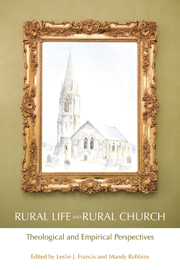Book contents
- Frontmatter
- Contents
- Preface
- Foreword by The Bishop of Shrewsbury, The Rt Revd Mark Rylands
- 1 Introduction: shaping rural theology
- PART 1 PERSPECTIVES FROM THE BIBLE
- PART 2 PERSPECTIVES FROM ORDINARY THEOLOGY
- PART 3 THEOLOGICAL AND SOCIOLOGICAL PERSPECTIVES
- PART 4 HISTORICAL PERSPECTIVES
- PART 5 LISTENING TO VISITORS
- PART 6 LISTENING TO THE COMMUNITY
- 18 Social capital generated by two rural churches: the role of individual believers
- 19 Local festivals in two Pennine vill ages: the reactions of the local Methodist church congregations
- 20 Extended communion: a second best option for rural Anglicanism?
- PART 7 LISTENING TO CHURCHGOERS
- PART 8 LISTENING TO CHURCH LEADERS
- PART 9 SATISFACTION AND STRESS IN MINISTRY
- Contributors
- Sources
- Subject Index
- Name Index
18 - Social capital generated by two rural churches: the role of individual believers
from PART 6 - LISTENING TO THE COMMUNITY
- Frontmatter
- Contents
- Preface
- Foreword by The Bishop of Shrewsbury, The Rt Revd Mark Rylands
- 1 Introduction: shaping rural theology
- PART 1 PERSPECTIVES FROM THE BIBLE
- PART 2 PERSPECTIVES FROM ORDINARY THEOLOGY
- PART 3 THEOLOGICAL AND SOCIOLOGICAL PERSPECTIVES
- PART 4 HISTORICAL PERSPECTIVES
- PART 5 LISTENING TO VISITORS
- PART 6 LISTENING TO THE COMMUNITY
- 18 Social capital generated by two rural churches: the role of individual believers
- 19 Local festivals in two Pennine vill ages: the reactions of the local Methodist church congregations
- 20 Extended communion: a second best option for rural Anglicanism?
- PART 7 LISTENING TO CHURCHGOERS
- PART 8 LISTENING TO CHURCH LEADERS
- PART 9 SATISFACTION AND STRESS IN MINISTRY
- Contributors
- Sources
- Subject Index
- Name Index
Summary
Abstract – Extended interviews were conducted in 2003 with eight people who had affiliation with two churches within a large village. The interviews were analysed to assess whether these individuals were contributing to the social capital of their own church-related community (bonding social capital), and whether they were contributing to the social capital of the wider community (bridging social capital). The data demonstrated a positive answer on both accounts.
Introduction
Social capital has been developed in recent years as an analytical tool which explores the nature of social cohesiveness and the value which can be added or subtracted from social life by the contribution arising from social activity and social networks in a given population. It has been broadly defined as based on ‘connections among individuals – social networks and the reciprocity and trustworthiness that arose from them’ (Hall, 1999, p. 417). An alternative definition is given by Robert Putnam as ‘features of social organization, such as networks, norms, and trust that facilitate coordination and cooperation for mutual benefit’ (Putnam, 2000, p. 18). L.J. Hanifan, a pioneer of the concept, illustrates how it applies to individuals defining social capital as ‘those tangible substances [that] count for most of the daily lives of people: namely, goodwill, fellowship, sympathy and social intercourse’ (Hanifan, 1916, p. 130).
These definitions, though couched in very general terms, show that human life-chances and general welfare are affected by the quality of social interaction within social institutions, but also relate to the quality of input which individuals subscribe to the ongoing life of their local community.
- Type
- Chapter
- Information
- Rural Life and Rural ChurchTheological and Empirical Perspectives, pp. 216 - 228Publisher: Acumen PublishingPrint publication year: 2012



